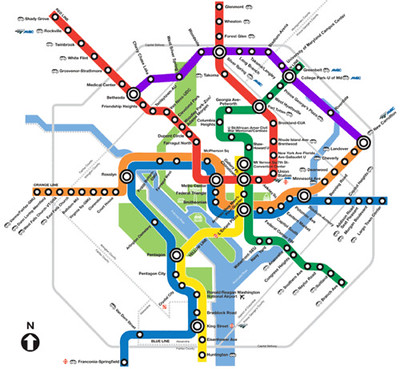A tax break isn't always the "right" priming lever for desired development
The Washington Business Journal reports ("Montgomery County eyes property tax breaks for projects on Metro-owned sites ") that Montgomery County Council is considering a 100%, 15-year tax break, to speed up housing development at Metrorail sites. From the article:
Legislation on the subject is set to be introduced at the County Council Tuesday as part of an ongoing effort by a group of lawmakers to ramp up residential development in the Maryland suburb and help the county realize its housing production goals. This new tax incentive, along with a host of others, has been in the works for months.Stations with the most opportunity for complementary real estate development tend to be closer in. FWIW, I have written many times that there is no such thing as "automatic" TOD (transit oriented development).
This latest measure, authored primarily by Councilmen Andrew Friedson, D-Bethesda, and Hans Riemer, D-At large, would create a payment in lieu of taxes program for any private developer leasing land from Metro to construct new high-rise buildings.
The bill would abate 100% of real property taxes for these projects for up to 15 years, starting when use and occupancy permits are issued for the property. County staff would then negotiate some other form of payment with the developers in question, though the legislation does not set standards for that process.
 Metrorail Map showing the Purple Line light rail line, which is currently under construction.
Metrorail Map showing the Purple Line light rail line, which is currently under construction.For various reasons, especially stations farther from the core of a metropolitan area, housing is less attractive and still requires a car, even if it's located at a transit station. This is true for light rail, heavy rail, and commuter rail.
-- "Prince George's County still doesn't get "transit oriented development" and walkable communities: Greenbelt edition" (2012)
-- "With "transit-oriented development" urban design and/or planning is destiny" (2009)
Glenmont Station is about 12 miles from Downtown DC. Forest Glen is closer, but is bracketed by the I-495, the Beltway Freeway. Shady Grove is 24 miles from Downtown DC.
I don't think the issue is taxes. Developing on transit agency land is really hard. (1) Cost in terms of money and time is an issue, because the development process for transit agency land is super convoluted because it takes an inordinate amount of time, for example, the development at the Takoma Metrorail Station has been "underway" for 20 years !!!!!!!!!!!!! and is no way near any resolution.
(2) Besides the problems of contracting with a government agency anyway, (3) it requires a federal review, since federal funds had been involved in the development and operation of the system; and (4) residents opposed to development seek various additional reviews and often the intercession of the Congressional representatives.
Hard projects get developed once all the easy sites are taken. If (5) the station isn't well located relative to housing demand, that makes it even more difficult.
While not in Montgomery County, but in Prince George's County, there has been a transit development plan for the West Hyattsville station for at least 15 years. Although last year WMATA did sell land there, and a development program is apparently underway.
The problem is, more marginal development sites won't get developed til all the better sites are developed successfully.
Basically, the "problem" in Montgomery County is the stations that haven't been developed, in particular Shady Grove and Glenmont, are distant from the core and don't possess the characteristics that tend to draw "urban-oriented" residents who are the kind of people who want to live in housing at transit sites.
A tax break isn't going to change that reality.
More importantly, rather than offering a tax break willy nilly, I'd offer a tax break conditional on a plan and program for achieving multiple planning-related objectives. The article says that's intended, but not defined in the legislation. That's never good.
Purple Line and TOD tax breaks. Because they'll be closer in, I'd say with the Purple Line, at the very least the Chevy Chase (Connecticut Avenue) station will be more in demand--also because it's in a much higher income area--than the outlying Metrorail Stations, while the Long Branch Station will not be, because it's in a lower income area--even though both stations will be located about 7 miles from Downtown.
I'd consider including stations like that, where the normal development timeline would be much longer, for tax breaks over a station like Shady Grove or Glenmont, because Purple Line stations are closer in, closer to the core, while Shady Grove and Glenmont are end of the line stations that are very suburban, and lack the pre-conditions for urban intensity.
Labels: real estate development, real estate financing, tax incentives and abatements, transit and economic development, transit oriented development



0 Comments:
Post a Comment
<< Home